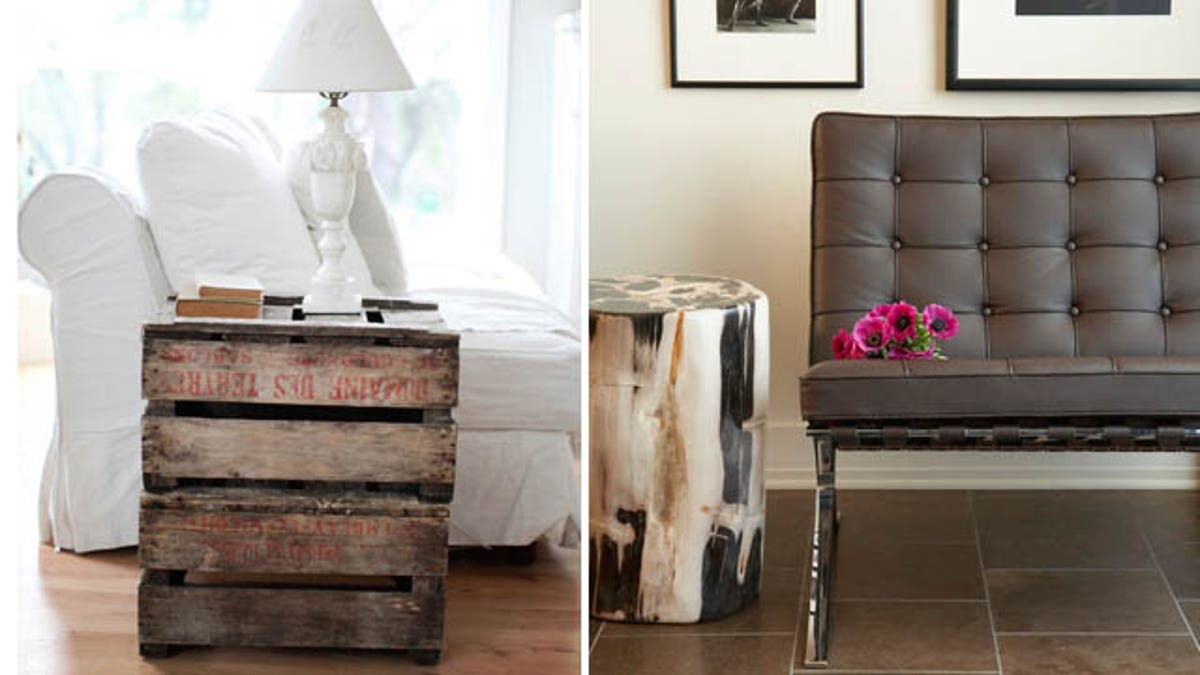
A contemporary living room, left, by Dreamy Whites, and a modern living room, right, by Niki Papadopulous with end tables to match the respective decor. (Houzz / Dreamy Whites / Niki Papadopoulus)
End tables are like the supporting players to a leading-lady sofa. They rarely get the glory, yet they're vital in their own low-key way. In addition to serving as a landing pad for lamps and a perch for cocktails, they can help to give a space a well-rounded, polished look. They whisper of a homeowner who pays attention to details.
That said, they can be tough to get right. They come in a daunting array of styles, sizes and finishes, and because you typically need two rather than one, you want to be doubly sure you choose winners. I've had a harder time shopping for end tables than any other piece in my living room -- I've waffled over heights, surfaces, base styles and materials in an effort to strike the perfect balance of function and finishing touch. When I find it, I'll let you know.
In the meantime, rely on these guidelines to help you in your search.
The number-one question when choosing an end table: How tall should it be? The rule of thumb is that its surface area should be equal to or just below the height of the sofa arms. For a standard sofa, that's around 25 inches, but get out the measuring tape to be sure (I did, and it's a good thing -- the arms on mine hit 28 inches). Most end tables are between 22 and 30 inches.
If you can't find tables you like within your target height range, err on the side of shorter rather than taller. Styles that jut above arm level not only can look awkward, but they also can make it hard for people to set down a glass or pick up a book.
These tables break the height rule, but they work for two reasons: One, the tables' bottom tiers sit below the sofa arms and within easy reach. And two, the floor-to-ceiling windows and draperies elongate the space visually, so the composition can stand a boost in elevation, exaggerated by the pair of lamps.
Nesting tables also let you get away with a little extra height. Leave the shorter table pulled partially or completely out from the taller one to create an engaging layered effect.
What about armless sofas? You have two options: Select tables that suit the height where arms would sit (to gauge it, get comfy on the sofa and reach for an imaginary drink), or buy low models that are level with the seat. Neither option is better than the other; it just depends on your preferences and the balance of your space.
This isn't technically a sofa (it's Mies van der Rohe's iconic Barcelona Chair), but the principle applies just the same -- the tabletop lines up with an imaginary arm. Its chunkiness helps to ground the leggy seating, and its cylindrical form brings a needed curvy element that offsets the succession of right angles.
If you like the mismatched look, choose tables similar in size and visual weight for harmony. These each fall at roughly the same height as the sofa arms. Notice how the square table is tucked into the corner, a nice match for its angles.
Of course, there's no law that says you have to double up on end tables if the look doesn't jibe with your space. A single tray table at the far end of this sofa preserves the inviting openness of the room, and the arrangement is evened out by the folding table that sits on the diagonal across from it.
Feel free to use nontraditional objects -- shipping crates, old suitcases, sewing machine stands, garden stools -- as end tables. Just make sure they fall in step with the height and scale guidelines above so that they are conversation pieces rather than nuisances.
Related:
- Photos: Get Inspired by Thousands of Fanciful Living Rooms
- Home Remodeling: Find a Design Professional In Your Area
- Living Room Furniture: Get Inspired to Decorate
Houzz is the leading online platform for home remodeling and design, providing people with everything they need to improve their homes from start to finish -- online or from a mobile device. From decorating a room to building a custom home, Houzz connects millions of homeowners, home design enthusiasts and home improvement professionals around the world. Lisa Frederick is a contributor to Houzz.